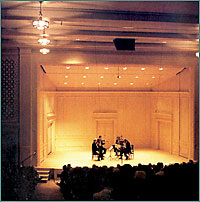 If you follow popular music, you likely saw in June that Sir Paul McCartney—in Washington to receive the Library of Congress Gershwin Prize for Popular Song—not only sang at the White House but also, the night before that elegant gig, performed at a venue at the Library known as the Coolidge Auditorium.
If you follow popular music, you likely saw in June that Sir Paul McCartney—in Washington to receive the Library of Congress Gershwin Prize for Popular Song—not only sang at the White House but also, the night before that elegant gig, performed at a venue at the Library known as the Coolidge Auditorium.
You might also have noticed that the Coolidge was the site of Stevie Wonder’s premiere, a year earlier, of his piece “Sketches of a Life,” which the Library commissioned from him in conjunction with his receipt of the Gershwin Prize in 2009.
The 500-seat Coolidge is even cooler than that among devotees of classical music. Since its opening of the concert hall in October, 1925 following a gift from Elizabeth Sprague Coolidge, a wealthy aficionado of chamber music, it has been the first-performance site of such works as Aaron Copland’s “Appalachian Spring,” Igor Stravinsky’s “Apollon Musagète,” Maurice Ravel’s “Chansons Madécasses,” Ned Rorem’s “Evidence of Things Not Seen” and string quartets by Béla Bartók, Arnold Schoenberg, Benjamin Britten, and Sergei Prokofiev.
Performers on its stage have included Bartók, György Kurtág, Joshua Bell, Leonard Bernstein, Dave Brubeck, Savion Glover, Leontyne Price, Rudolph Serkin, Bobby Short, and some of the world’s finest chamber-music ensembles, from the Juilliard String Quartet to the contemporary classical sextet eighth blackbird. Recently, the Dalai Lama spoke from the stage of the Coolidge.
Each year, in addition to a season of free concerts by world-famous chamber-music groups, (although there is a minimal fee payable to a ticketing service to make sure seats don’t get double-booked) there are performances by jazz combos and folk musicians. Stars who are members of the songwriters’ rights group ASCAP and hit-makers from the world of country music have played there recently. The Coolidge is, as they say, “music to your ears.”
That’s a good thing, because even though the auditorium is part of the lavishly embellished Thomas Jefferson Building, the Coolidge isn’t exactly eye candy. That’s how the patron wanted it: she sought “severe and chaste beauty” rather than “ornate display.”
The walls are flat, with minimal decoration–a little molding, a bit of metalwork–and cream-colored paint; the theater-style seats are padded, but not plush, and the floor is covered with medium-brown tiles made from cork.
There is no carpet.
There is no curtain.
Ornate, it’s not.
But close your eyes when there’s someone on that storied stage and be carried away on a wave of sound–because the Coolidge is what sound engineers call a “live” hall. Its acoustics can move the sound waves from a single violin or a small group of instruments out and out so that the 499th person back there in the last row can hear the sound quite clearly, without amplification.
That cork floor may be part of the secret – along with the empty space below the stage, the design of the roof, the sound-reflecting angle of the back wall. Whatever it is, it’s made the Coolidge world-famous among musicians.
History is replete with costly, beautiful concert halls that became infamous for their sonic dead spots. There’s a concert hall in New York City named after the generous gentleman who paid to have its acoustics redone several years after it opened – years after that, more work is scheduled. Many a stage manager has struggled with acoustic “holes” in the audience, or with stage acoustics that keep singers from hearing the music, or musicians from hearing each other – it’s all too common.
But only a few halls are as reliably delightful to the ear as the Coolidge – perhaps the Musikverein in Vienna, or Symphony Hall in Boston. And when you scrutinize them, you’ll see that they, too, went easy on the carpeting and velvet wall covering, letting the sound bounce all around instead of being absorbed.
The hard wooden floorboards on the Coolidge stage fairly glow with memories of the luminaries who have spoken there, sung there, played there, danced there. It’s the plain-Jane frame to some priceless artistic portraits.


Comments (4)
The Coolidge Auditorium it’s a magnificent and it’s said that his acustic is superb.Added all of this to prescense of an idol like Paul mcCarney,and I’m totally sure than the velue was a sensational success.Congratulations by the organisators.
One of my all time favorites performances (concerts) was in 2006- rock-a-billy legends Sonny Burgress and the Pacers! There is a webcast of it http://www.loc.gov/today/cyberlc/feature_wdesc.php?rec=4360
I find its greatest beauty, and have heard maybe 100 concerts there, is with un-amplified, pre-18th century instruments like the Library’s Strads, or better yet, lutes, recorders, and early keyboards. You can hear all the notes of all the instruments.